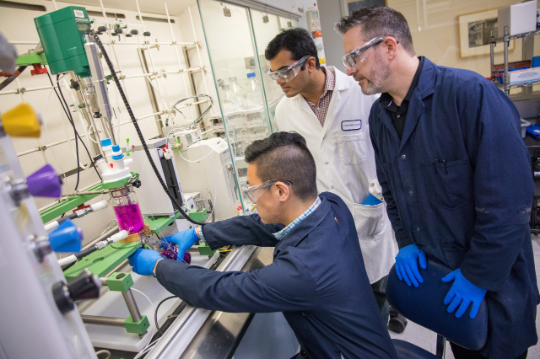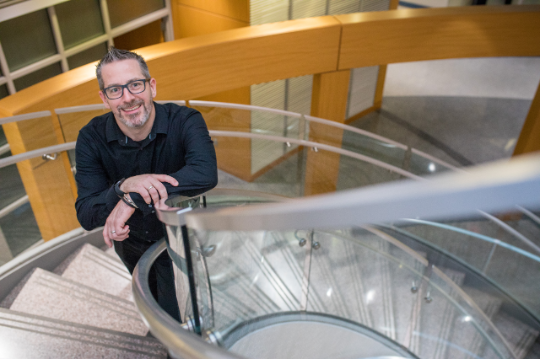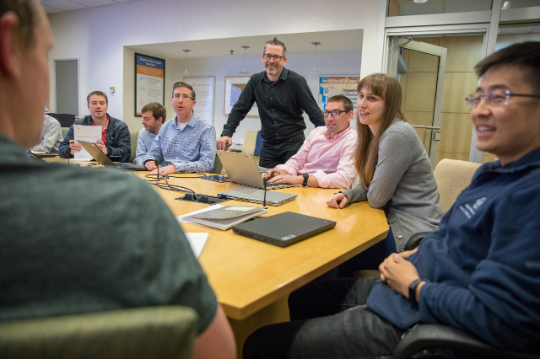Sustainability in 2022 and beyond - Bristol Myers Squibb - Our stories
Our science & innovation

Sustainability today and beyond
What we’re doing to reduce global environmental impact throughout the product lifecycle
As a leading global biopharmaceutical company, Bristol Myers Squibb develops and delivers high-quality products that help people around the world suffering from serious diseases. That’s a great responsibility — and it’s closely connected to our critical accountability to be good stewards of the global environment. In every aspect of our business, we seek to ensure that our vital work treating patients does not create impacts that damage the health of communities and ecosystems.
Among our key objectives is to minimize the environmental costs of the chemical compounds we use and manufacture. In the past year, BMS advanced that goal on several fronts, through an integrated approach involving functional areas across the organization as well as partnerships with other stakeholders across the globe.
“Greening” a new product
On the product development side, our environmental efforts are aligned with the American Chemical Society’s principles of “green chemistry” — an approach to the design, development, analysis and implementation of chemical products and processes that focuses on preventing pollution, reducing waste, increasing reliance on renewable resources, and reducing or eliminating the use and generation of hazardous substances.
“Our driving ambition is to bring top-flight therapeutics to patients using methods that are simultaneously sustainable, robust and reliable,” said Martin Eastgate, executive director of Portfolio Chemistry in Chemical Process Development.
One notable achievement stemmed from the development of our novel treatment for moderate-to-severe plaque psoriasis, which launched in the United States in 2022.
Our chemists established an extremely efficient approach to this important molecule, ensuring that it can be manufactured both reproducibly and sustainably. “The initial route to our TYK2 asset was brilliant in terms of delivering high-quality drug substance,” Eastgate explained, “but we also saw an important opportunity to enhance the sustainability of the manufacturing process and support commercial supply more efficiently.”
Finding a new route
To do so, the team needed to develop an innovative new route to the molecule. “Innovation is critical to developing robust and sustainable ways to prepare our clinical candidates,” Eastgate said. “These are not mutually exclusive objectives, but we often need a deep understanding of the options and risks to accomplish both goals.”
After determining the best way to build the molecule, he and his colleagues employed an “every unit operation” approach, in which each step that goes into manufacturing is explored in detail. “We optimize things like solvent utilization, analytical methodologies, and the kinds of reagents and reactants that are used, while ensuring the final product is isolated in high quality.”
This strategy led to notable improvements in sustainability and eliminated all the halogenated solvents from the manufacturing process while reducing waste by 74%, energy usage by 73% and water consumption by 78% — a consummate example of sustainability and manufacturing performance working hand in hand.
Creating new tools and protocols
Eastgate and his colleagues have developed multiple tools to enhance their efforts, such as the PMI Predictor, which uses predictive algorithms to help select the most efficient routes to new molecules. They have also developed a protocol for evaluating each element of a manufacturing process to identify areas of inefficiency, called process assessment and cost evaluation (PACE), which the team uses to improve overall sustainability in our commercialization of new small molecules.
Award-winning results: Waste reduction of nearly 86%
The results of such assessments, when coupled to the team's scientific insights, recently earned BMS and partner Codexis the 2023 Peter J. Dunn Award for Green Chemistry for another molecule — the LPA1 antagonist BMS-986278, an investigative treatment for pulmonary fibrosis. “The old route was appropriate for early development, but required improvement for commercialization,” said Eastgate. “The innovative approach the team developed reduces consumption by nearly 86% — potentially eliminating thousands of tons of waste once launched.”
Members of the Chemical Process Development team are now performing studies to understand the robustness of a new asset under investigation, in hopes of realizing similar results when that drug comes to market. “Our goal is to sustainably deliver lifesaving medications to patients,” Eastgate said.
 |
To me, this is such a noble cause — fighting disease while preserving the planet.” | |
Martin Eastgate, Executive Director, Portfolio Chemistry, |
Our environmental
commitments
We intend to achieve:
purchased electricity from
renewable sources by 2030
zero-emission vehicles
in our fleet by 2040

Reducing the environmental impacts of pharmaceutical ingredients
BMS is working to mitigate the environmental impacts of our ingredients at every stage of the product lifecycle. While patient excretion is the primary source of active pharmaceutical ingredients (APIs) entering the environment, the improper disposal of unused/expired medications and manufacturing effluent discharge are also contributing factors. We address these problems before, during and after our medicines reach patients.
To prevent APIs and other potentially harmful substances from going where they’re not wanted, BMS follows stringent corporate standards and guidelines regarding the treatment and management of wastewater at our manufacturing sites. We conduct environmental fate/effects studies and risk assessments for all new medicines when applying for approval, in accordance with local regulations. We’re committed to transparency in reporting the environmental data we collect, making information available to the public through partnership initiatives (such as the FASS API database) and on our safety data sheets.
We also strive to minimize the environmental impact of unused, unwanted or expired drugs. Our patient takeback program in the U.S. is managed by the Pharmaceutical Product Stewardship Work Group, a consortium that coordinates these efforts through the stewardship organization MED-Product. Due to varying local regulations regarding waste disposal, it’s impossible to calculate the total amount of unused BMS products collected from patients. However, we know that in 2022, residents of California, Massachusetts, Oregon, New York and Washington disposed of nearly 440 tons of medications through MED-project’s programs.
In addition, we collaborate with other organizations to facilitate takeback in our industry. Examples include the websites myoldmeds.com and medsdiposal.eu, which enable patients to identify a nearby location where they can properly dispose of unused drugs.
Seeking a better understanding of the risks
Another way in which BMS is working to mitigate the impact of APIs in the environment is through research aimed at developing a better understanding of the potential risks those substances pose. In 2022, we initiated an ecopharmacovigilance program to monitor our products post-launch by tracking the scientific literature for emerging data on exposure and effects.
We also contribute to global efforts in this area as a member of the Prioritisation and Risk Evaluation of Medicines in the Environment (PREMIER) project, funded by the European Commission and the European Pharmaceutical Industry.
Launched in 2020, the six-year project brings together a multidisciplinary consortium of 25 partners from public and private sectors in Europe and the U.S. Its central goal is to design a novel information and assessment system for identifying and addressing the environmental risks of medicines — especially for those with limited data availability, as is the case for many of the nearly 2,000 APIs currently in use.
“We’re developing tools to identify and predict potential environmental impacts associated with our medicines,” said Todd Davidson, director of Environmental Toxicology and Product Stewardship at BMS. “That could allow us to proactively manage any potential impact of medicines in the environment and consider alternate approaches that minimize environmental impact.”
Together, BMS and PREMIER advance sustainability with global approaches
The consortium’s main objectives include:
- Exploring the feasibility of greener drug design and development
- Developing a risk-based framework to prioritize the environmental assessment of existing medicines that have no data
- Generating environmental data for up to 25 existing medicines to validate the prioritization framework
- Launching an evidence-based, transparent and publicly accessible database collating physicochemical and environmental properties of medicines.
- Creating an information and assessment system to guide regulators, water managers and other stakeholders in identifying and managing any environmental risks associated with patients’ use of medicines.
BMS is involved in many aspects of this work, with a focus on developing new computer-based models to predict concentrations of drugs in the environment.
PREMIER published its first two papers in 2022, on a physiologically based kinetic model for bioaccumulation in fish in the journal Environmental Science and Technology, and on a proposed set of criteria for the development of sustainable pharmaceuticals in Environmental Science and Technology Letters. The former is aimed at improving the efficiency of environmental risk assessments and reducing animal use, while the latter begins to assess the feasibility of greener drug design.
 |
This kind of research is crucial for helping us make medicines that are better for the planet as well as our patients.” | |
Todd Davidson, Director, Environmental Toxicology and Product Stewardship |
